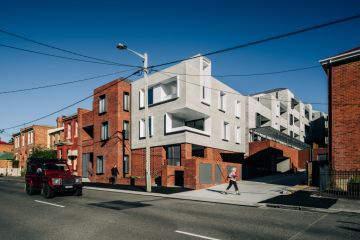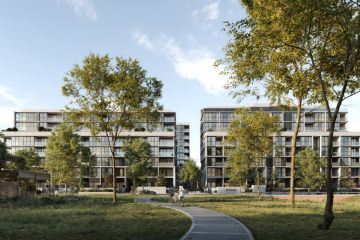Renovation rock stars: expert advice from Shaynna Blaze, Peter Maddison and Jamie Durie

They don’t call it renovation hell for nothing. Cost overruns, endless waits for those Italian tiles you’ve chosen, the structural wall that you pulled down yourself to save money and now you need an army of tradespeople and a sympathetic bank manager to come in and save you.
Don’t worry. It doesn’t have to be this way.
Three experts share their tips on how to avoid renovation hell, complete with the stories about those who have learnt the hard way.
Shaynna Blaze
Interior Designer & Co-host of Selling Houses Australia

Interior designer Shaynna Blaze. Photo: Scott McNaughton
Hottest trend?
Butler’s pantries. It’s one of those things I don’t think enough people are questioning whether they need. It’s a separate kitchen behind a kitchen that supports the main kitchen. It has a dishwasher, it houses all your cutlery and your crockery. Until now the bathroom has been the luxury item; having an incredible master en suite has been one of the biggest trends in the past five or six years. Now it’s the butler’s pantry. A lot of people are spending too much money on a butler’s pantry that they won’t even use.
Top tip?
Work out your budget and where to put the money to get the best back out of it. It’s honing in on how you want to live and how best to spend the money to make it work for you.
Biggest renovation disaster?
Of course it’s none that I’ve done. There was one on Selling Houses Australia where a couple decided to do a renovation without any plans or council permits. They took down a supporting wall and didn’t put a structural beam in so everything was falling. Everything they did was beyond building code so the house ended up being really dangerous and they couldn’t sell it. DIY reno? Great. But before you pull out a wall, make sure it’s not a supporting wall. Get some expert advice. We had to waste a lot of money fixing their mistakes.
Perfect client?
It would be someone who completely trusted me, gave me lots of money and didn’t question it. They need to have an idea of the direction. If people say, “Do whatever you want”, you’re never going to tap into what they actually want. You want a client who is open to really different ideas. As a designer you want to bring something new to the table and, if they’re not going to let you, it’s difficult.
Worst client?
A lady who had just gone through a major divorce and had her new place. I presented the design and it was fantastic. But when everything was bought and brought in, she hated everything. “Oh, I didn’t think it would be like that.”
It didn’t matter what I brought in, she hated it. In the end I just said “You know what? I don’t think anything I’m going to bring to the table is going to make you happy.” I took it all back and gave her a refund.
It taught me a lot, to really engage the conversation more with what they want. She thought she knew what she wanted but she didn’t. I was a bit out of pocket, but it was a big learning experience for me.
Biggest budget overrun?
Probably one of my own. The big reno in the studio I have now. It was a place we had a vision for. But until we pulled out the wall, we did not know what we were going to get into.
Selling Houses Australia series nine will air on Foxtel’s LifeStyle Channel next year
Jamie Durie
Designer

Jamie Durie. Photo: Steve Christo
Hottest Trend in renovating?
A greater connection to the outdoors. We have reached the pinnacle in trying to open up every single room of the home to the garden. We’re now starting to look at ways of bringing the garden into the home and reconnecting our lives with nature, in and out.
My team have developed this term “transterior” because all the furniture we design is built for the outdoors but also the indoors. We use material that can withstand the elements but we leave the choice to the homeowner as to where they put the piece of furniture. The outdoor furniture is luxurious enough to make it look like it should be indoor furniture. People don’t want barriers between the outside world and the interior.
Top tip for a successful project?
Good planning.
Biggest renovation disaster?
I once saw a slab poured at the wrong height, in Melbourne. It was two feet (60 centimetres) lower than it should have been. To redo it doubled the cost and they lost $180,000. Put it this way: that house will never wash away in the rain.
Perfect client?
I don’t think I’d design for anyone who didn’t have faith in me to begin with. I’ve been really lucky in that everyone I’ve worked with has given me free rein to come up with ideas that they feel will suit them. I had a great time working with Charlize Theron. I found her to be extremely stylish, very environmentally conscious and, aside from being one of the most beautiful women in the world, she was very down to earth.
Worst client?
I’ve had some clients who don’t know when to let go, which is always tough. They’re control freaks and they don’t know when to trust a professional. Design these days is as much about psychology as it is about design. You’ve got to manage their expectations. You’ve got to under-promise and over-deliver. And you’ve got to constantly make them feel like they’re the ones leading you down the path rather than the other way round.
Biggest budget overrun?
Probably 40 per cent.
Most common renovation mistake people make?
They simply don’t plan. When you don’t plan you wind up going over budget, you start one trade before another one’s finished so all the trades are overlapping each other. Good planning will save you money and deliver a more accurate, precise design and, ultimately, a better return on investment.
Peter Maddison
Architect & Presenter, Grand Designs Australia

Peter Maddison. Photo: Scott McNaughton
Hottest trend?
The dreaded butler’s pantry. Why they’re popular, I just can’t make out. Is there some embarrassing cringe about anyone seeing a mess? You prepare in one room and you serve it in a pseudo kitchen out the front. It is certainly a trend that kitchens are viewed more like a piece of furniture rather than a living, breathing, pragmatic workplace.
Top tip?
Lots of pre-planning, at least a year out. I had someone come to me last week who wanted to settle on a property in six weeks and wondered whether the builder could start then. It just doesn’t happen that way. It comes down to getting all the design work done and having it pre-costed before it goes to the builder, so there’s no rude shocks. You need to get all the drawings costed as you go along. And employ professional people to do the design and engineering work. The more decisions you make up front, the easier the construction process. It’s all about lead times. You can’t walk into a shop and say I want marble tiles and expect them to be in stock. It can be a 12-week lead time.
Biggest disaster?
My own house. I bought an old 28-bed nursing home in 1989. I didn’t realise how far I would have to go to strip it out. Interest rates went to 18 per cent. I spent three years toiling on it myself, late nights, weekends, doing a lot of the heavy labouring and helping all the tradies to try to manage the cost.
After three years, my wife and young family moved in and I ended up working for the banks. I had no money. I didn’t have two 20-cent pieces to rub together. The bottom fell out of the market and, after spending hundreds of thousands of dollars on the renovation, we ended up selling it three years later and getting less for it than we paid for it in its unrenovated state.
It took more than 10 years for me to recover mentally and financially. I was pushed into a Californian bungalow in a poor state and we had to live in that … and I wasn’t at all proud of what we ended up doing. It’s hard for me to live with. It was easily the biggest disaster I’ve witnessed.
Perfect client?
Someone who is on the same page as me, someone who sees value in paying the architectural fee and invests in an architect’s skill base. You give more as an architect if there’s an emotional commitment to the job. And that client understands what you’re doing. Also someone who pays their bills on time.
Worst client?
Many years ago I did a house in Mount Eliza and the client got all the drawings off me and then didn’t pay. That is devastating. It’s a problem with the architectural process where you do the work, then invoice and wait for it to be paid. There’s some idea that professions have lots of money and they don’t need to get paid for a long time. That’s not the case.
Biggest budget overrun?
Projects generally don’t go over budget because we have them carefully cost-planned. We don’t do a job – big or small – without using an independent cost planner. We’ve done 300 projects and I can’t remember one that’s really raced away.
Anything that has surprised you?
I’m doing my own house at the moment and it always amazes me how many things can go wrong. You can have the best drawings in the world and it can take one tradesman to make his own decisions and it can have a knock-on effect right through. The attention to detail you have to have in a renovation project is enormous.
The nuances and detail are vast. In my house I ordered the marble four months before the project was starting. It turned out it had all been sold so I was forced to select marble that was available in Melbourne. I’m then limited to a small selection.
The fittings arrived. Two out of three were smashed and now I can’t get it done in time. The bath arrived yesterday – it was perfectly packaged and six guys carried it in and (it turned out) there was damage to the side of it. To get another bath is going to hold up the whole project.
Biggest mistake people make?
There are so many. It’s a mistake to think you can probably live through it. You can’t. Better to get out of the house. People don’t often understand how much work there needs to be on infrastructure to make it work.
Season six of Grand Designs Australia will air later this year on Foxtel’s LifeStyle Channel.
We recommend
We thought you might like
States
Capital Cities
Capital Cities - Rentals
Popular Areas
Allhomes
More







